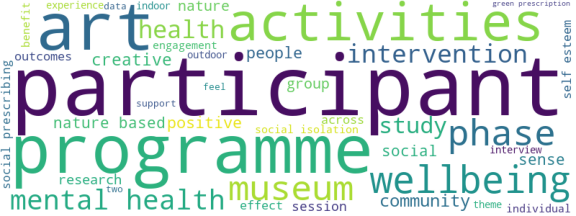| Id | 696 | |
| Author | Thomson L.J., Morse N., Elsden E., Chatterjee H.J. | |
| Title | Art, nature and mental health: assessing the biopsychosocial effects of a ‘creative green prescription’ museum programme involving horticulture, artmaking and collections | |
| Reference | Thomson L.J., Morse N., Elsden E., Chatterjee H.J.; Art, nature and mental health: assessing the biopsychosocial effects of a ‘creative green prescription’ museum programme involving horticulture, artmaking and collections ;Perspectives in Public Health vol:140 issue: 5.0 page:277 |
|
| Link to article | https://www.scopus.com/inward/record.uri?eid=2-s2.0-85085355604&doi=10.1177%2f1757913920910443&partnerID=40&md5=950cc736ef44b3c4f2cece7e200968a4 |
|
| Abstract | Aims: To assess the biopsychosocial effects of participation in a unique, combined arts- and nature-based museum intervention, involving engagement with horticulture, artmaking and museum collections, on adult mental health service users. Methods: Adult mental health service users (total n = 46 across two phases) with an average age of 53 were referred through social prescribing by community partners (mental health nurse and via a day centre for disadvantaged and vulnerable adults) to a 10-week ‘creative green prescription’ programme held in Whitworth Park and the Whitworth Art Gallery. The study used an exploratory sequential mixed methods design comprising two phases – Phase 1 (September to December 2016): qualitative research investigating the views of participants (n = 26) through semi-structured interviews and diaries and Phase 2 (February to April 2018): quantitative research informed by Phase 1 analysing psychological wellbeing data from participants (n = 20) who completed the UCL Museum Wellbeing Measure pre–post programme. Results: Inductive thematic analysis of Phase 1 interview data revealed increased feelings of wellbeing brought about by improved self-esteem, decreased social isolation and the formation of communities of practice. Statistical analysis of pre–post quantitative measures in Phase 2 found a highly significant increase in psychological wellbeing. Conclusion: Creative green prescription programmes, using a combination of arts- and nature-based activities, present distinct synergistic benefits that have the potential to make a significant impact on the psychosocial wellbeing of adult mental health service users. Museums with parks and gardens should consider integrating programmes of outdoor and indoor collections-inspired creative activities permitting combined engagement with nature, art and wellbeing. © Royal Society for Public Health 2020. |
|
| Keywords | creative activities; green prescriptions; mental health service user; mixed methods; museum intervention; psychological wellbeing; social prescribing |
Wordcloud:



